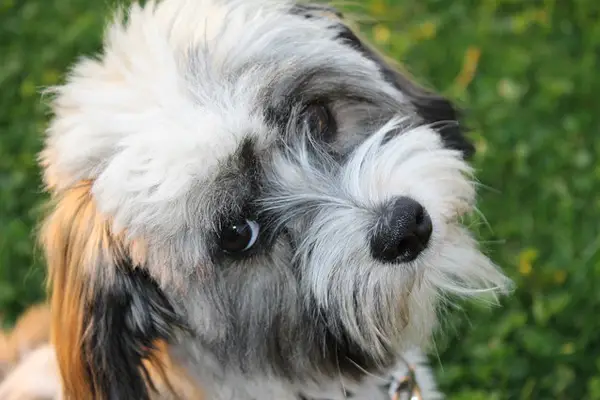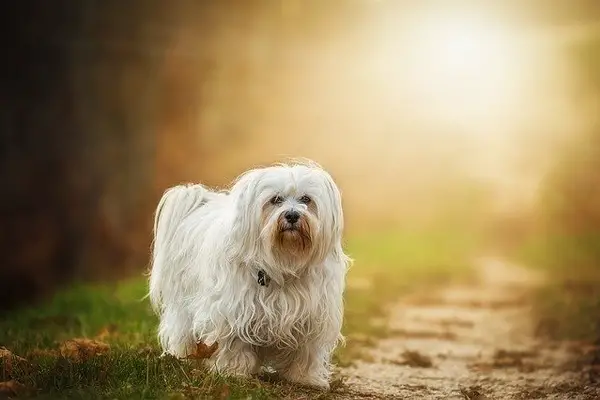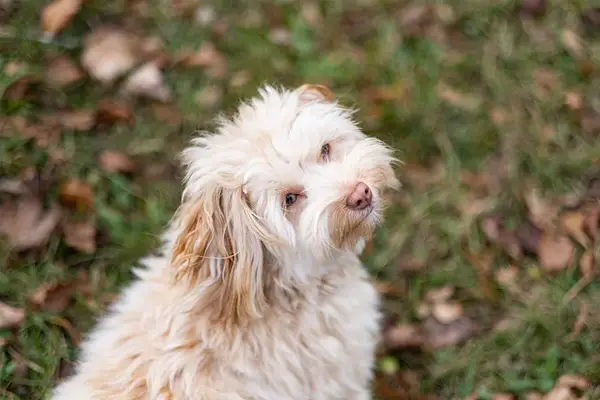The Havanese dogs are small-sized dogs that only grow by up to 12 inches. They feature a curled-over tail and long silky coat. They come in various colors, which is one reason why they’re one of the most preferred dog breeds. You can style their long fur in two ways – cording or just let it down – but they look adorable no matter what.
They rank 24th as the most popular dog breed in the US, mainly because of their affectionate nature. They love people, and most even refer to them as “Velcro dogs” because they’re always behind or beside their humans. However, you can’t consider them as lap dogs because they are extroverted as well. They are smart, trainable, and excellent watchdogs.

Havanese Statistics
| Dog Breed Group | Toy Group |
| Height | 8.5-11.5 inches |
| Weight | 7-13 pounds |
| Lifespan | 14-16 years |
Havanese Ratings
| Energy level | |
| Exercise needs | |
| Requires attention | |
| Playfulness | |
| Trainability | |
| Shedding | |
| Grooming | |
| Friendly with family | |
| Friendly with strangers | |
| Friendly with other dogs | |
| Prey Drive |
Havanese History
The Havanese is believed to be the only dog breed that originated from Cuba. They are believed to be descendants of the Bichon family of little white dogs brought to Cuba by Spaniards in 1492. Isolated on that island, the dogs interbred and resulted in the Havanese we know today.
The name Havanese came from the capital city of Havana, which was the area where they were most popular. Their silky, long coat is said to be protecting them from the hot tropical sun of the island, but this also attracted the noble and wealthy families in Cuba.
By the 1800s, the Havanese dog breed became more and more popular. First in England, Spain, France, and soon, all of Europe. They are even popular with royalties such as Queen Victoria, who also loved the dog breed.
Unfortunately, as the years grew, the dog’s popularity slowly declined. Only a few wealthy families have been keeping them, and they almost went into extinction. That was until the year 1959, during the Cuban Revolution when Cubans brought 11 Havanese dogs to the US.
These 11 Havanese became the foundation of saving the breed. As they were intelligent and affectionate, Americans became fascinated with them and continued breeding them until there were more Havanese outside of Cuba.
By 1995, the American Kennel Club recognized the Havanese dog breed, and they became one of the most popular dog breeds, even with celebrities, up to this day.

Havanese Temperament
Havanese dogs are known to be extroverts. American Kennel Club describes them as intelligent, outgoing, and funny. Plus, they are very affectionate with their family.
This dog breed thrives for human companionship. If you have a Havanese, expect that he will follow you wherever you go. They will not be the right dogs if you’re continuously outside for work; this dog shouldn’t be left at home for long.
They’re prone to separation anxiety and will get lonely without their humans. And if they’re alone, you can expect excessive barking and chewing of furniture. In other words, they can become destructive.
Although they might make excellent lapdogs, this dog breed is still highly energetic. They love playing games and learning new tricks. So, it’s best if you spend some time training him too. As they are highly intelligent, teaching them is quite easy.
Havanese dogs are also friendly and gentle with everyone, that includes strangers and other animals. However, it would require early socialization for this trait to come out. At best, they are conservative.
They make excellent watchdogs even if they are not the aggressive type, so it’s something you won’t need to worry about.
All in all, these dogs are one of the sturdiest dogs despite their small size. They do have an independent nature, but they’re not dominant dogs. Include treats in your training, and he would undoubtedly love joining competitive contests.
Havanese Care Requirements
- Nutrition: Havanese, just like every other dog, needs a high-quality diet to maintain an optimal health condition. This is also very important in keeping their coat silky and healthy. As Havanese is a small dog breed, overfeeding them is easy, which is why you need to be very careful with the number of calories you feed her. This will also depend on the activities she’s doing in a day and, of course, her age. You can consult with your vet about the specific amount of calories to feed your Havanese. If you’re opting for feeding your Havanese some commercial products, make sure that this only contains high-quality ingredients. This means, stay away from fillers and by-products as these have low nutritional value and will not benefit Havanese dogs in any way. The safest option is to feed your Havanese home-cooked meal. Typically, this should contain 50% of animal protein to provide your small dog enough energy. 25% of the diet should contain carbohydrates, and the remaining 25% should be from fruits and vegetables.
- Grooming: Havanese’s coat sheds twice a year. However, brushing their hair should be done regularly, even if it’s not shedding season. This is so you can maintain the silky appearance of their coat, which is their ultimate feature. At the same time, brushing prevents the coat from matting. As Havanese’s coat tends to grow long, some owners trim them short. If you need this done, make sure that you have an expert do it. Bathing them should be done occasionally too. I recommend sending them to a groomer for some overall grooming, which will include bathing and trimming, which is probably once every few months. At the same time, you can also ask to have your dog’s nails trimmed so he can walk and run without pain. Clean the ears too, or you can let an expert do it, but the outside is something you can handle. Wipe clean the corners of their eyes to avoid eye irritation.
- Exercise: Havanese dogs need moderate exercise. They can stay inside the house all day without complaints, but exercise will keep them happy. They certainly love brisk walks, playing games, and learning new tricks as these are activities he can do with you. In other words, they just really enjoy spending time with their humans. You can even create some inside-home games just to keep him out of boredom. Be careful not to over-exercise this breed. Always observe any change of breathing, and if there is, it’s time to go home.
- Health: Havanese are prone to several health problems. An owner needs to be aware of such so you can prepare for possible screening tests you may want your dog to undergo. Legg-Calve-Perthes Disease is one common disease that Havanese dogs are prone to. This is why the blood supply to the head of the femur lacks, which causes it to degrade. Another leg disease you may want to watch out for is Patellar Luxation, which happens when the kneecap is no longer in position. Havanese are also prone to eye diseases such as cataracts. Congenital deafness is common too; however, this might be something the Havanese can quickly adapt to. You can also watch out for obesity, allergies, liver shunts, heart murmurs, and osteochondrodysplasia. Regular check-ups will help in monitoring your dog’s health condition. If you have observed symptoms, be sure to take him to the vet. Let him take some screening tests if it’s available so you can rule out some medical conditions. For those that are caught through the genes, you can meet the parents and see if such medical conditions exist as well.
- Lifespan: The life expectancy of the Havanese is 14-16 years.

Famous Havanese
- Tim: Charles Dickens’ Havanese and playmate of his seven children
- Cha-Cha: Barabara Walters’ Havanese who helped the popularity of the breed
- Harold Reginald Williams: Venus Williams’ Havanese
Fun Facts About Havanese
- Havanese are the only dog breed that came from Cuba.
- The Havanese silky coat protects them from overheating.
- They have hypoallergenic coats; they’re excellent pets for people allergic to dog fur.
- Havanese have a unique bouncing walk that makes them look like skipping; sometimes, they even hop.
- They are also called Havana Silk Dog because of their silky coat.
- Queen Anne and Queen Victoria both owned a Havanese.
- They come in many colors: gold, black, blue, silver, cream, champagne, chocolate, and combination.
- They almost came to extinction in the 50s and 60s.
The post Havanese appeared first on Furry Friends Gear.
Havanese posted first on https://furryfriendsgear.tumblr.com
No comments:
Post a Comment